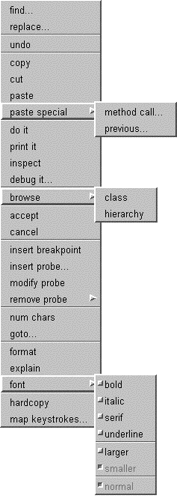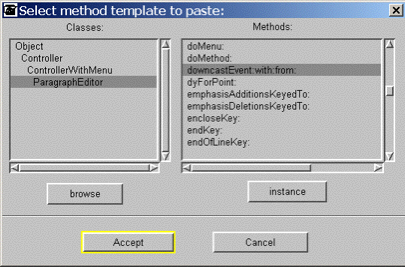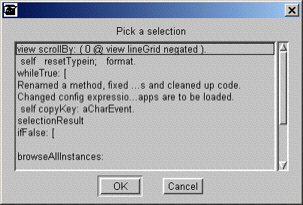 Paste Special menu:
Paste Special menu: Paste Special menu:
Paste Special menu: This causes a
chooser window dialog to pop up with the hierarchy of the current class
listed on the left side. On the right side is a list of the instance
or class methods for the selected class. If the user selects a class
and method name combination and then presses the accept button, a
method call template will be pasted into the text. This functions is
also available from a keystroke if the pasteMethodTemplateKey:
method has been mapped
to a keystroke.
This causes a
chooser window dialog to pop up with the hierarchy of the current class
listed on the left side. On the right side is a list of the instance
or class methods for the selected class. If the user selects a class
and method name combination and then presses the accept button, a
method call template will be pasted into the text. This functions is
also available from a keystroke if the pasteMethodTemplateKey:
method has been mapped
to a keystroke.
Using the supplied dialog image as an example, if the user presses the Accept
key, the following text will be pasted into the existing text:
self
downcastLocalEvent: aKey with: aParameter at: aPoint from: anInitiator
As in Class Hierarchy browsers,
clicking on the instance
button will change the list of instance methods to a list of class
methods.
If the selected method is a class
method and the template is being pasted into an instance method, self class will be put at the
beginning of the template text rather than just self.
Clicking on the browse
button will abort the dialog
and will open a Class Hierarchy browser on the selected class, and the
existing text will remain unchanged.
If a method is selected when the browse button is pressed, that
method
will be automatically selected in the new browser.
The automatic selection of the method can
be turned on
or off using code in the supplied DevTools
workspace.
Clicking on the Cancel
button at any time will abort the dialog and the existing text will
remain unchanged.
See EtAbstractMethodsBrowser>>pasteMethodTemplate
and its callers
for additional
details.
 previous...
previous...
This provides a menu interface to an
existing, but
not well-publicized, feature in VisualWorks.
If the previous...
menu item is chosen, or the Shift
key is held while the
'paste' menu item is chosen, a
dialog pops up displaying the list of items in the paste history
buffer.
If one of the items is chosen, and the OK button is pressed, the item is
pasted into the existing text.
This functions is also available from a
keystroke if the pastePrevious:
method has been mapped
to a keystroke.
Clicking on the Cancel
button at any time will abort the dialog and the existing text will
remain unchanged.
See ParagraphEditor>>pastePrevious
and its callers
for additional
details.
A new feature has been added to these
menu items.
If do it, print it, or inspect is selected, the executed
text is pushed onto the top of the paste history buffer. The contents
of the clipboard remain unchanged.
This function can be particularly useful if there is a need to execute
the same piece of code on multiple inspected objects.
The paste history buffer can be accessed using the paste previous menu item.
The copying of executed text to the paste history buffer by the do
it, print it, or inspect menu items can
be turned on or off using code in the supplied DevTools
workspace.
See ParagraphEditor>>evaluateSelection
and its callers
for additional
details.
If any text is currently selected, the
selection is
copied to a buffer, and a line with "self halt." is put in the
buffer before the text. The text in the buffer is then treated as if
the
user had chosen ‘do it…’ from
the pop-up text pane menu. A "halt"
debugger window is pops up, and the programmer can employ it in the
normal
manner. The selection in the original window will not be modified in
any
way. This function is also available from a keystroke if the debugItKey:
method has been mapped
to a keystroke.
The menu item debug it... can
be removed from the menu using code in the supplied DevTools workspace.
See ParagraphEditor>>selectionAsDebugStream,
ParagraphEditor>>debugSelection
and their callers
for additional
details.
 Browse
menu:
Browse
menu:This menu item parses and evaluates the
current text
selection. A Class browser is opened on the class of the
result. This function is also available from a keystroke if the browseClassKey:
method has been mapped
to a keystroke.
See ParagraphEditor>>browseClassKey:
and its callers
for additional
details.
This menu item parses and evaluates the
current text
selection. A Class Hierarchy browser is opened on the class of the
result. This function is also available from a keystroke if the browseClassHierarchyKey:
method has been mapped
to a keystroke.
See ParagraphEditor>>browseClassHierarchyKey:
and its callers
for additional
details.
 Font
menu:
Font
menu:If any text is selected, then the font
and/or font style is changed. If no text is selected, then the font
and/or font style is only changed for any text that is typed after the
current
cursor location. This function is also available from a keystroke
if the VisualWorks provided changeEmphasisKey:
method has been mapped
to one or more keystrokes.
See the following methods of ParagrahEditor
and their callers
for additional details:
>>fontBold and >>isSelectionBolded
>>fontItalic and >>isSelectionItalicized
>>fontLarger and >>isSelectionLargerFont
>>fontNormal and >>isSelectionNormal
>>fontSerif and >>isSelectionSerif
>>fontSmaller and >>isSelectionLargerFont
>>fontUnderline and >>isSelectionUnderlined
This menu item opens a DispatchTable
editor for the Editor controller of the current window pane
and all others like it. This function is also available from a
keystroke if the mapKeystrokesKey:
method has been mapped
to a keystroke.
The menu item map
keystrokes... can
be removed from the menu using code in the supplied DevTools
workspace.
See implementors of >>mapKeystrokes
and their callers
for additional
details.